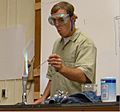Analytical chemistry facts for kids
Analytical chemistry is a special part of chemistry. It's all about figuring out what chemicals are in something and how much of each chemical there is.
Imagine you have a mystery drink. An analytical chemist could tell you if it has sugar, how much sugar, and what other ingredients are in it! They use special tools and methods to do this.
Analytical chemistry helps us:
- Separate things: Like taking apart a mix of different candies.
- Identify things: Figuring out what each candy is.
- Quantify things: Measuring how many of each candy there are.
For example, an analytical chemist might find out how much zinc is in a piece of brass (which is a mix of metals). Sometimes, they just need to separate things. Other times, they need to identify them. And often, they need to measure the exact amount.
There are two main ways analytical chemists work:
- Classical methods: These are older, "wet chemistry" ways. They often involve mixing liquids and watching for changes.
- Modern methods: These use fancy instruments and machines.
Contents
Classical Methods
Classical methods are like the original chemistry experiments. To separate things, chemists might use:
- Precipitation: Making a solid form in a liquid.
- Extraction: Pulling one chemical out of a mixture.
- Distillation: Heating a liquid to turn it into a gas, then cooling it back into a liquid to separate it.
To identify chemicals, they might look at things like:
- Color or smell
- How hot something needs to be to melt or boil
- How easily it dissolves
- How it reacts with other chemicals
To measure how much of something there is, classical methods often involve weighing things or measuring how much liquid is used.
Instrumental Methods
Modern analytical chemistry uses amazing instruments! These machines can separate, identify, and measure chemicals very quickly and accurately.
Some ways instruments separate samples include:
- Chromatography: This separates mixtures as they travel through a material, like different colored inks spreading on a paper towel.
- Electrophoresis: This uses electricity to separate tiny particles.
After separating, instruments can identify and measure chemicals by looking at how they interact with:
- Light: Like how a prism splits light into colors.
- Heat: How chemicals react to changes in temperature.
- Electric fields: How chemicals behave with electricity.
- Magnetic fields: How atoms react in strong magnetic fields.
Often, one single instrument can do all three jobs: separate, identify, and quantify!
Improving Analytical Chemistry
Analytical chemistry is always getting better! Scientists are always working on:
- Better ways to design experiments.
- Using chemometrics, which is like using math and statistics to understand chemical data.
- Creating brand new tools and instruments to measure things.
This field is super important! It helps in many areas, like:
- Medicine: Developing new medicines or checking blood samples.
- Science: Understanding how the world works at a chemical level.
- Engineering: Making sure materials are strong and safe.
Did you know? The very first instrumental analysis was created by two scientists, Robert Bunsen and Gustav Kirchhoff, in 1860. They used it to discover two new elements: rubidium (Rb) and caesium (Cs)!
Images for kids
-
Gustav Kirchhoff (left) and Robert Bunsen (right)
-
The presence of copper in this qualitative analysis is indicated by the bluish-green color of the flame
-
A huge machine called an accelerator mass spectrometer. It's used for things like radiocarbon dating (finding the age of old things).
-
This shows how black ink can be separated into different colors using a method called thin-layer chromatography.
-
This is a Fluorescence microscope image of two mouse cell nuclei. The scale bar helps you see how tiny it is (5 µm is 5 millionths of a meter!).
See also
 In Spanish: Química analítica para niños
In Spanish: Química analítica para niños











